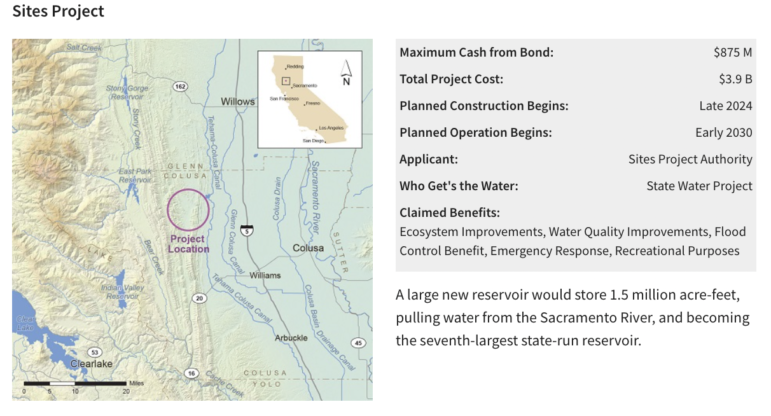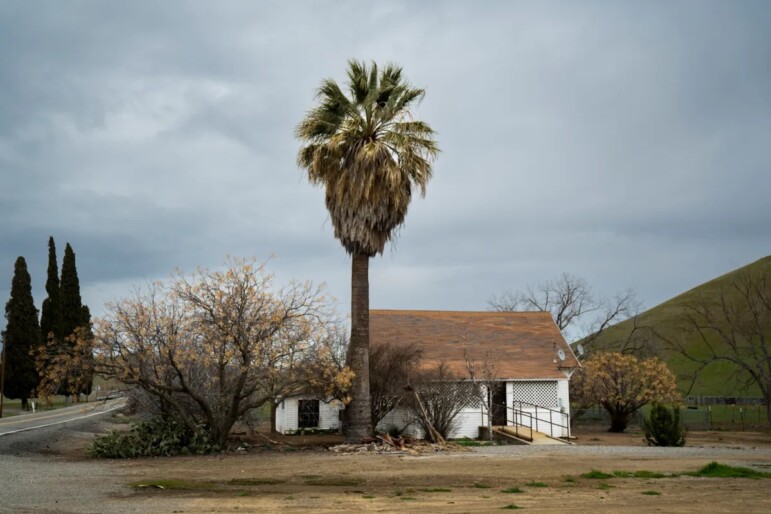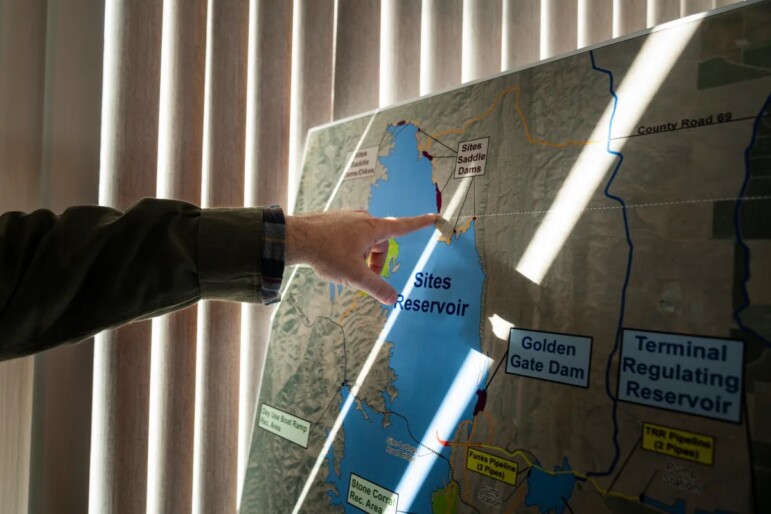Last century, California built dozens of large dams, creating the elaborate reservoir system that supplies the bulk of the state’s drinking and irrigation water. Now state officials and supporters are ready to build the next one.
The Sites Reservoir — planned in a remote corner of the western Sacramento Valley for at least 40 years — has been gaining steam and support since 2014, when voters approved Prop. 1, a water bond that authorized $2.7 billion for new storage projects.
Still, Sites Reservoir remains almost a decade away: Acquisition of water rights, permitting and environmental review are still in the works. Kickoff of construction, which includes two large dams, had been scheduled for 2024, but likely will be delayed another year. Completion is expected in 2030 or 2031.
Sites Reservoir would store as much as 1.5 million acre-feet of Sacramento River water and could eventually boost water supplies — especially in dry years — for more than 24 million people, mostly in Southern California, and 500,000 acres of Central Valley farmland. The reservoir is now projected to cost $4.4 billion, with Prop. 1 covering up to $875 million and much of the rest coming from federal loans to water suppliers.
For years, state lawmakers, farm representatives and city water suppliers have bemoaned that the reservoir hasn’t been built yet, and their criticism has escalated during rainy periods.
In less than two weeks of storms last month, Sites could have captured 120,000 acre-feet of water, enough to serve about 1.3 million Californians for a year, according to water agencies supporting the project.
Rep. John Garamendi, a Democrat from Walnut Grove, is one of many long-time Sites advocates who have grown impatient waiting for the new reservoir.
“California just received 22 trillion gallons of rainwater last month, which could have filled Sites and provided a greater supply of water for the dry months,” Garamendi told CalMatters.

Gov. Gavin Newsom has rallied for the project, and his 2022 water strategy outlined a plan to create as much as 4 million acre-feet of new water storage space.
The Metropolitan Water District of Southern California, one of many potential investors, might get as much as 20% of the reservoir’s water. The Coachella Valley Water District, Santa Clarita Valley Water District and Bay Area residents also could be receiving Sites’ water.
Once built, the reservoir will almost certainly provide water storage benefits for people. But whether it will benefit the environment or not is being debated.
Environmental groups oppose the reservoir, fearing it will draw too much water from the Sacramento River and harm imperiled populations of salmon and other fish. An environmental review, which already has gone through multiple rounds of revisions and public comment periods, is still underway and could wrap up this summer.
The reservoir’s slow pace of progress doesn’t surprise leaders and water supply experts.
“For any large gray infrastructure project, permitting and planning are stages that take time,” said Nina Hawk, chief of Bay-Delta Resources for the Metropolitan Water District, which has chipped in about $30 million for Sites planning.
Jerry Brown (not the former governor of the same name) of the Sites Project Authority, which represents local water districts pursuing the project, said it takes many years to develop and plan projects of this scale.
“My personal rule of thumb is that for every year of construction you spend about three years in the planning-permitting-engineering stage,” he said. Since Sites’ construction takes six years, the process would be expected to take 18 years.
Who gets the water? And how much?
Proponents say the Sites Reservoir is a necessary step to bolster California’s water supply, which is increasingly strained by drought as well as intense wet weather and flooding. Moreover, pressure is on Southern California to sharply cut its use of water from the Colorado River, perhaps increasing the importance of Delta water to Southern California.
Sites would make a small splash in California’s water supply: Major reservoirs now hold 50 million acre-feet and Sites would add only about 1.5 million more. The Delta’s state and federal systems export an average of 4 to 5 million acre-feet a year. (An acre foot is about 326,000 gallons.)
“It’s an increase of a few percent, but it’s real water to someone,” said Jay Lund, a UC Davis professor of civil and environmental engineering.
The Metropolitan Water District — which delivers 1.6 million acre-feet of imported water a year to 19 million people — would receive about 50,000 more from Sites., adding just 3% to its supply.
Another water district, the Zone 7 Water Agency that serves 270,000 people in the East Bay, would receive about 10,000 acre-feet annually from Sites, increasing its supply about 20%. Valerie Pryor, its general manager, said frequent droughts and residential demand have squeezed supplies, making Sites an appealing option.
Most of the Zone 7 agency’s water comes from the State Water Project, which is increasingly strained by drought and so far this year will deliver only 35% of requested water.
“With declining reliability and some population growth, we do need some additional water supply,” Pryor said. She added that stormwater capture and continued conservation efforts will only go so far in making ends meet.
Climate change models suggest California will see longer, drier droughts and shorter but more intense wet periods – a pattern that has emerged prominently in the past several years. This is the sort of pendular weather pattern that Sites is being designed to take advantage of, by grabbing water when it’s abundant.
A massive project: How the reservoir will be built
Named for the historic quarry town of Sites, which will be submerged if the project is built, the reservoir would occupy remote hills and creek valleys west of the Sacramento River. Two large dams would contain the water, along with seven structures called saddle dams, which will close in the northern side of the basin like the rim of a large bowl.
Sites Dam will be nearly 300 feet high and more than 700 feet in length; Golden Gate Dam will be about the same height and three times as long. The saddle dams, though not as tall, will be huge features, as well: One is sketched out in planning documents at 3,422 feet in length. Also included is a pair of tunnels 23 feet wide and 3,000 feet long. Building all of these features will account for much of the reservoir’s $4 billion price tag.
Mixing concrete for the dams could require as much as a million gallons of water per day for four years.
Other big tasks include buying land from local owners, ripping out a country road, demolishing structures, removing septic systems, clearing trees, scouring out mountains of topsoil and distributing it to local farms, and relocating two private cemeteries.
About 15 families live in and near the town of Sites, so building the reservoir will require their relocation. Brown, the project authority’s executive director, said acquiring the private properties will be included in the project cost.

About 160 miles of existing canals will be used to transfer water into and out of the reservoir, with plans to build just 20 miles of new conveyance, according to Brown. Energy to pump water into the reservoir — a lift of 300 feet — will come from hydroelectricity generated by the dam’s outflow, plus a planned solar array.
Brown said the availability of preexisting canals makes the project viable.
“If we didn’t have all of that, this project would not be affordable,” he said.
Sites would be different from most of California’s other large reservoirs. Shasta, Oroville, Hetch Hetchy and many others were built by damming large rivers. But Sites would be what’s called an off-channel reservoir, built away from the river. During storms it will fill with water, which will be delivered via canals and pipelines.
What are the environmental impacts?
Off-channel reservoirs can cause less environmental harm because they don’t block major fish migration routes. Still, environmentalists have questioned the reservoir’s feasibility and operation: Will there be enough water to fill it? And what impacts will doing so have on fish and other wildlife in the Sacramento River?
John McManus, president of the Golden State Salmon Association, noted that few, if any, of California’s dams have been beneficial for Chinook salmon. Today, several native fish species are close to extinction, and the commercially valuable fall-run Chinook salmon may be in danger of dropping below fishable numbers, which could lead to a shortened fishing season this summer, or a complete closure.
McManus thinks operation of Sites Reservoir will worsen the Chinook’s plight. “We don’t need more reservoirs and dams that will divert more water from the rivers,” he said.
Biologist Carson Jeffres is on the fence about the project. Jeffres, a senior researcher at the UC Davis Center for Watershed Sciences, said the impact will depend on how and when water is diverted from the Sacramento River to fill it. He worries that filling the reservoir could drain the floodplains along the river used by fish and wildlife.
“I see so much potential and so much peril at the same time,” Jeffres said. “The details of the operation will determine how this plays out.”
The Sites planning process has involved multiple rounds of environmental impact reports and a few major changes to the design plan. A 2017 environmental review was deemed incomplete, leading to a revised draft in 2021. In May, the Sites authority is releasing its final report addressing the potential environmental impacts.
There was a big hiccup last year, too, when the State Water Resources Control Board ruled that the project’s application for water rights did not adequately analyze water availability. The water board is currently mulling over a possible, controversial update to its plan, which would require that 55% of the river’s unimpaired flow reach San Francisco Bay for environmental benefits. The board determined that the Sites analysis failed to “assess or consider” these changes.
The Sites Project Authority resubmitted a more thorough analysis in January and is now waiting for the board to issue a water right that will allow the reservoir to divert water.
Water board officials declined an interview request. But in a brief written statement they said before a water right is granted, “the board must ensure that instream flows necessary for the protection of water quality, fish and wildlife in the Delta can be met sustainably.”
“At this point we are at the finish line with what we intend to proceed with,” Brown said. “We are full-steam ahead.”
Among changes to lessen the environmental impact, the reservoir’s capacity has been downsized from 1.8 million acre-feet to 1.5 million.
Doug Obegi, a water attorney with the Natural Resources Defense Council, said there’s simply not enough water left in the Sacramento River most years to operate Sites without causing more harm to critically endangered fish.
“A project that is biologically sustainable is not cost-effective, and a cost-effective project leads to extinction, and that is the rub,” Obegi said.
Costly water
The reservoir must provide public benefits in order to receive Prop 1 funding. This money is allocated under the assumption that operating the reservoir will provide recreation opportunities, ecosystem and water quality improvements and enhanced flood control for downstream communities.
Paul Cambra, a public information officer with the California Water Commission, said an assessment of these public benefits will ultimately determine whether all, or just a portion, of the Prop 1 funding will support the reservoir’s construction.
A 2022 federal loan of $2.2 billion and a $449 million loan from the U.S. Department of Agriculture to the Sites Project Authority, plus a financial pledge from the U.S. Bureau of Reclamation, will cover much of the rest of the cost.

Once built, the reservoir’s water will cost about $750 per acre-foot, according to Brown.
“That’s at the reservoir,” he said. The farther it travels, the more the water costs for the recipient, and for Metropolitan, Hawk said, the final cost per acre-foot will be roughly $1,000 to $1,300 — considerably more than the average State Water Project’s cost of $667 per acre-foot.
But Kightlinger, who helped conduct detailed cost-benefit analyses of the project when he worked for Metropolitan, said it’s a lot cheaper than desalinating water.
The Sites reservoir “saves us billions and billions” that would be spent on desalination, Kightlinger said.
Pryor, at the Zone 7 Water Agency, said she understands the need for a cautiously paced planning stage “for a mega-project” like Sites. However, with every drought and deluge that comes, the reservoir’s absence is sorely felt.
“The last three dry years, we were thinking, ‘Wouldn’t it be great if Sites was here?’” she said. “And with the January storms we had, we were thinking, ‘Wouldn’t it be great if Sites was here?’”
